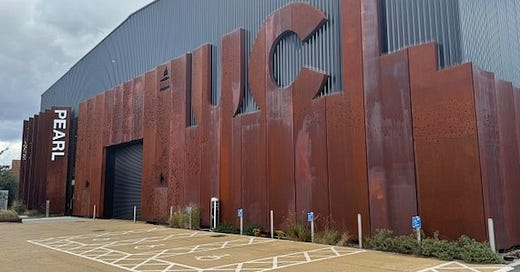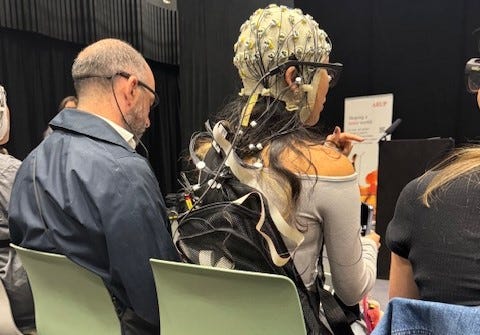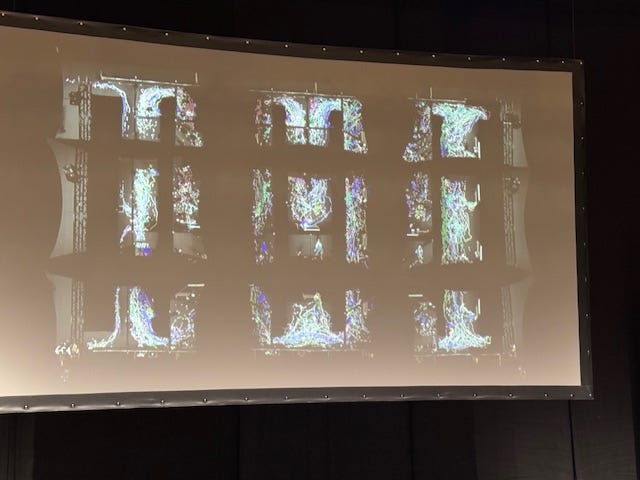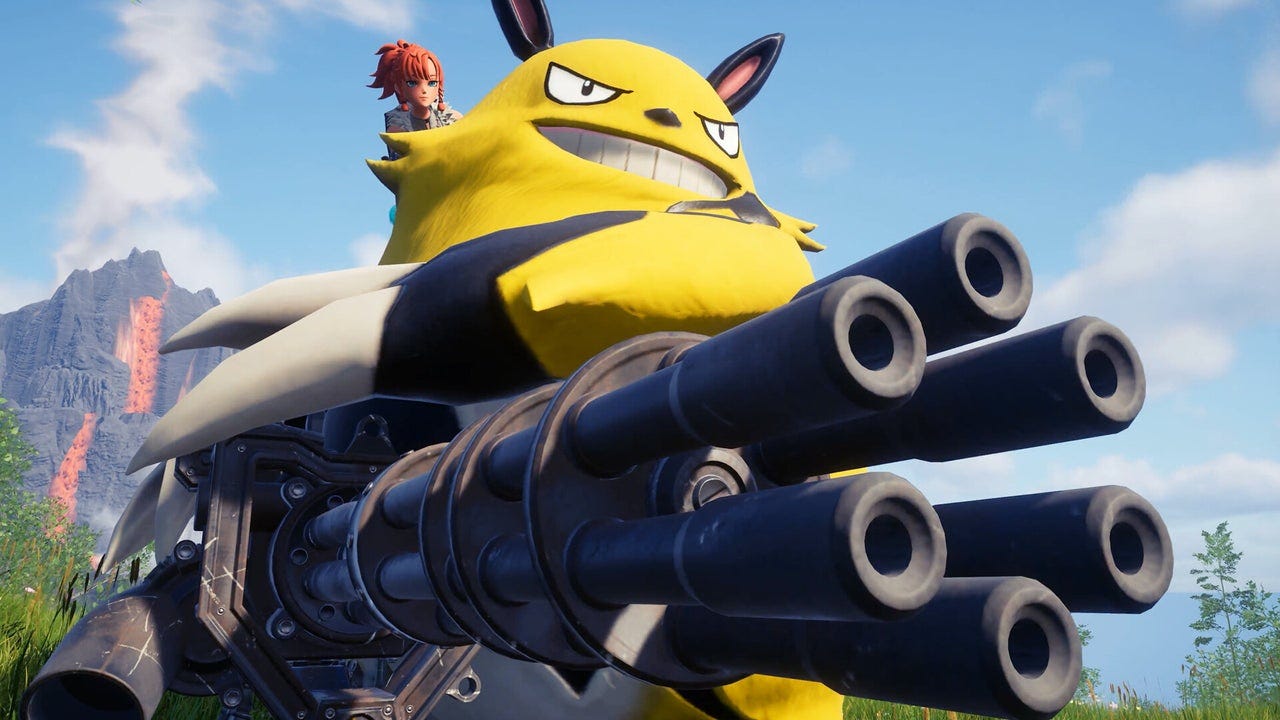Neuroarchitecture and video game design, 19/09/2024
I go inside UCL's 'CERN for the mind' for work reasons, I promise
I find out what links a swanky science lab and the video game Sea Hero Quest
Nintendo and The Pokemon Company sue the makers of Palworld
The Plucky Squire fights off other top releases to grab my heart this week
Good morning VGIM readers,
I’ve got three things for you before we go into this week’s newsletter.
First, there are still sponsorships available for the ludicrously popular AI and Games Conference.
The event, which is taking place on Friday 8th November at Goldsmiths University, sold out completely last week after a flurry of interest from the community.
While we are bumping the ticket numbers up to 250 to allow more people through the door, sponsoring is the best way to guarantee your company’s place at the event and get brand visibility in with Europe’s leading game AI experts.
If you’d like to sponsor the conference and join us in November, pop me an email to george@half-space.consulting pronto.
Next, I have space for two more growing games businesses to mentor through my work with the teams at Codebase and Barclays.
I’ve been running monthly hour-long sessions with a couple of companies over the past few months to guide them on how to tell their story effectively to corporate audiences, such as investors.
Thankfully, it’s gone well so far. One of my mentees wrote to me a couple of weeks ago to say my tips on how to tighten their business pitch deck was “a crucial factor in us securing our funding” and that this success has put their business “in a much stronger position than when we first started these sessions.” Sobs.
So if you’re an ambitious games business who wants a bit of my time to boost your corporate story-telling, you can request mentoring from me here.
And finally, a quick note on the next two newsletters.
VGIM will be out as usual on Thursday 26th September and Thursday 3rd October, with a couple of particularly tasty big reads to enjoy.
However, I will be scribbling those newsletters over the course of a fortnight where I’ll be spending at least 36 hours in the air and setting foot on four different continents as book research kicks up a gear. Eep.
So while I intend to write two full fat newsletters in that time, I also ask for your understanding and forgiveness if I skip the jobs round up at some point. It’s surprisingly time consuming, I swear…
Right, enough of all that: who fancies reading a piece about brains, buildings and video games then?
The big read - Neuroarchitecture and video game design
Always ask interesting people to tell you about something that they find interesting.
Whether you’re curious, easily bored or just enjoy riding the waves of our indifferent existence, asking one question of the right person can take you to some intriguing places - as I discovered rather literally last week.
At the beginning of August, I interviewed Max Scott-Slade, the co-founder of games for good studio Glitchers, about the transformative effect of the company’s game Sea Hero Quest on scientific understanding of spatial navigation.
During our chat about the game, which helped me understand how it collected the equivalent of over a century’s worth of scientifically valid navigation test data from 4.3m people around the world, Max mentioned that academics including Professor Hugo Spiers, Professor of Cognitive Science at University College London (UCL), guided its development to ensure its output matched the needs of academic researchers using it in contexts such as Alzheimer’s research (where the dataset has proven particularly handy).
Naturally, this was fascinating. So I asked Max whether he might be able to furnish me with an introduction to Hugo to help me understand more about his work.
Instead, he went one step further.
Shortly after our call, I received an invitation to participate in a showcase ‘neuroarchitecture’ experiment at UCL’s new Person-Environment-Activity Research Laboratory (PEARL) (described informally as ‘CERN for the mind’).
And while the experiment’s stated aim was the distinctly non video game related purpose of understanding “better how the people move in groups inside buildings”, Max teased that Sea Hero Quest would form a key part of the experiment.
Obviously, I was sold on coming along. So a little over a month after we first spoke, I found myself tramping past a Travelodge and a Costa Coffee Drive Thru on an industrial estate in Dagenham to reach the state of the art facility to find out what all the fuss was about.
And by the end of the afternoon, I ended proceedings convinced that a part of the scientific world that I hadn’t heard of until a month ago could intersect effectively with the video games industry I’ve known for over a decade.
PEARLY greats
There is little more exciting to a modern academic than smushing together ideas, datasets and sometimes entire disciplines for the purpose of finding stuff out.
Over the past couple of decades, academics have become increasingly interdisciplinary because cross pollination of skills, methodologies and thinking provides room for all kinds of breakthroughs.
Neuroarchitecture is a great example of this trend. First coined as a term by a gentleman called Fred Gage in 2003, the discipline combines the fields of neuroscience and architecture to understand how the way spaces are designed have both conscious and unconscious impacts on the way we think, feel and behave.
The field is generally important because it can be used to understand how and why we move around spaces like town squares or public transport in certain ways, improving the design of these areas in the process.
But neuroarchitecture's true significance appears to be in the more specific aim of helping architects to understand how to design spaces which more inclusively to account for the myriad different ways we think.
Whether it’s exploring whether Susan Cain’s contention in Quiet that open plan offices risk driving introverts to despair or by understanding early onset Alzheimer’s changes the way someone interacts with a space, neuroarchitecture adds a quantifiable scientific layer to efforts to make buildings and spaces more equitable for all - providing us all benefits in the process.
Its aim is noble. It is also, as many of you with a game design background will likely already be noting, similar to concerns shared by more progressive games businesses about their digital spaces.
The problem for neuro-architects, however, has been creating an environment in which to test design ideas against these considerations.
Whereas video game creators can build their ideas digitally, neuro-architects, understandably, ideally need both an adaptable physical space in which to test their thinking and access to technology to measure their hunches - something that is difficult to come by.
Enter PEARL. The 4000m2 facility, which was created with funding from UCL and the Research Institutes of Sweden, allows researchers to use materials within the facility to recreate life sized environments (like a railway station or a town square) and then use a veritable treasure trove of cameras, sensors and audio visual equipment to accurately track people’s behaviour within it.
The result is a controlled environment within which academics can literally see how people move through an authored space and meaningfully measure how they interact with it, aided by the handily pliable data set amassed from all those trackers.
It’s fascinating stuff. But as with just about everything in life, it makes a lot more sense once you’ve experienced it. And it was only after I had been into the heart of PEARL that I truly began to understand its value.
Testing times
We knew little about the experiment before we stepped into it. What we did know was that over 100 of us - most wearing hats with QR codes on, some wearing glasses with cameras in them and a handful wearing swimming hats with nodes attached to them - would enter an art gallery and, at some point, be asked to complete a task that lay in an envelope before us.
Prior to being shoved into the room, we were asked to do two things. After being assigned a number like we were extras in an episode of The Prisoner (I was number 11), we had to fill out a form where we answered a range of questions from how old we were, how introverted or extroverted we are and, interestingly for me, how often we played video games.
Then, while we waited for the brain cap people to have their tech checked (read: minds scanned by aliens, probably), we were assigned a code for Sea Hero Quest and told to play through some levels at our leisure.
As an insufferable Type A overachiever, I immediately downloaded the game, punched my number in and high scored my way through each of its ocean navigating levels. Esports teams: give me a call when you’re ready.
Shortly after that, the experiment started. After being guided to an entrance where we were waved into the test space by a Squid Game style flashing red and green light, we stepped into a mocked up art gallery that - as a result of its dark curtains and techno futurist art - immediately made me feel like I was in Alex Garland’s Ex Machina.
Fortunately, the first part of the experiment passed more peacefully than that film did. Aside from a brief Stanley Parable-esque moment in which 20 people (myself included) briefly escaped from the experiment’s boundaries, we moved around the space examining the art in the way that you would in any other gallery.
Quietly. Sedately. A little too politely.
The peace didn’t last though. Once we had all been decanted into the experiment, Hugo’s voice boomed out over a loudspeaker. It instructed us to open the envelope with our task on it to start the next phase of the experiment.
On it, was a massive grid full of numbers with no discernible pattern to them. However, it turned out that each number mapped to one of the works of art in the gallery which - crucially - were not arranged in numerical order in the facility. Our goal was to stop enjoying the art and to instead move from artwork to artwork in the order the sheet told us to, moving between them as efficiently as possible.
Instantly, the environment changed. The sedate strolling was replaced with a sudden purposeful busyness, with people striding around the gallery and pushing through the crowds to tick as many of their numbers as possible.
After bouncing around the room off the back of memory, gut instinct and the caffeine from my day’s third coffee, I did what any good video game player would do: I drew a mini map on the back of the task envelope to ease my navigation. And somewhat entertainingly, the two other people in the experiment who did work in games - Max, who was also in attendance, and a neuroscientist who works at a game technology provider - did exactly the same. Never tell me that video games don’t teach life skills ever again.
However, our cunning map plans were somewhat scuppered by one final surprise. After being told to pause on the spot, technicians entered the room and reset the gallery. While the artwork remained in the same place, the walls of the gallery had been reconfigured - forcing us to adapt our by then marvellously efficient movement strategies to meet the new challenge in front of us.
After roughly 40 minutes, we exited the experiment and filled out another form about our experience within the gallery.
We then returned into the room again for a further activity in which we were given the name of a city and had to find everyone else in the space who were handed the same location (Stockholm, represent), before trying to return to exactly where we stood when the task started.
Once that was done, the experiment concluded. After watching some final talks and a quick video about Sea Hero Quest, we wandered to the building next door to knock back a couple of Peronis and try to make sense of what happened to us.
Mind games
Unsurprisingly, we agreed that we couldn’t draw a clear conclusion over what exactly was being examined that day.
The talks at the end of the day showed us how much data they had generated - including heat maps of where we went, wire frames of our movement and event tracking of our interactions with the art - but they left us clueless of any wider possible meaning.
But what I concluded from the event, in the spirit of interdisciplinary thinking, is that there could be real value found at the intersection of neuroarchitecture and games design.
Initially, the thought started simply because the experiment felt more like a video game than just about anything I’ve experienced in the real world.
The way the first test in particular introduced a concept, gauged your understanding of it and then tested your mastery of it by twisting the formula immediately made me think of Mark Brown’s video about Nintendo’s philosophy for designing great Mario levels.
But beyond this surface level (and slightly glib) thought process, there felt like there was potential for a deeper connection between the two fields based on the way the people hosting the experiment spoke about the problems they faced.
The academics who spoke about the challenges that neuroarchitecture could address spoke in spatial terms that are familiar to games designers. How do we help people to instinctively and intuitively understand a route through a space? How can we make that process of pathfinding through a building inclusive to as many different ways of thinking as possible? And what are the best ways to track what’s happening in spaces to understand how to improve them?
But despite the intellectual similarities between the two disciplines, practically connecting them together was likely difficult. After all, how can neuro-architects hope to share lessons learned with digital designers effectively if they can’t quantifiably measure how real world design choices affect the way we think or move in a space?
It is this point that I think truly explains the significance of a facility like PEARL.
PEARL’s ability to allow neuro-architects to build a space, run experiments within it and gather tangible data from the tracking devices about the way people move in the space gives them a platform to test ideas and, crucially, meaningfully connect them to other data sets to generate insights.
In this experiment, it was Sea Hero Quest that the researchers connected to - creating a link between what we did in that room last Wednesday and the demographically relevant spatial data generated by the game in the past decade.
But more importantly, it is indicative of the interdisciplinary spirit that underpins the building’s creation.
PEARL isn’t just a facility for measuring data within a space; it’s a bridge for interdisciplinary thinking across a whole range of different fields. And if the work that game designers do to make their spaces more navigable and accessible can be fed into experiments conducted in PEARL, there’s a chance that lessons from our industry could be applied across a multitude of other academic disciplines - potentially changing the way we live our lives in the process.
I ended the day by reflecting back on something Max said to me in our interview in August. He told me that he believed that the potential for video games to positively impact society was so big that he couldn’t see the sides of it.
And after spending the day with him at the heart of PEARL, and getting a glimpse of how that could work practically in action, I definitely see where he’s coming from.
A brief note: This week’s News in Brief contains a lot of news from last week because everyone decided to announce everything after I’d hit publish last Thursday. Rude, I know…
News in brief
Worst of Pals: Nintendo and The Pokemon Company are suing Pocket Pair, the creators of Palworld. The companies allege that this year’s hit ‘Pokemon with guns’ game infringes multiple patent rights. Credit to Stephen Totilo of Game File, who broke the story exclusively yesterday.
nDream’s nightmare: VR games firm nDreams has announced plans to lay off 17.5% of its staff as the industry’s layoff woes continue. The company follows in the footsteps of companies like Microsoft - who slashed 650 jobs last week - in cutting its headcount, with the business blaming a ‘challenging VR games market’ and wider market issues for its downturn.
BEUC-aroo: The European Consumer Organisation (BEUC) has filed a complaint with the European Commission claiming that video game companies are misleading players into spending money. The complaint alleges that the practice of using virtual currencies instead of real cash value within games leads to players overspending, while also criticising companies for issues regarding their refund policies. I’ll be looking at this more closely in The Debrief next Friday.
Out of Runtime: Unity has cancelled its controversial Runtime fee, which imposed a ‘pay-per-download’ model on users of its development engine late last year. The fee, which was unpopular enough to spark a full blown rebellion amongst developers, and almost certainly cost former Unity exec John Riccitiello his job, was reversed by new head honcho Matt Bromberg in an effort to rebuild trust in the company’s mission to democratise development (and, y’know, make money).
Sayonara Wild Staff: The entire staff of Annapurna Interactive, the video game publishing branch of production biz Annapurna, resigned last week after negotiations to spin it off into a separate business collapsed. Developers who are releasing games via the company have reported that they are unaffected by the move. Separately, if you say the word ‘gullible’ really slowly, it sounds eerily like you’re saying the word “oranges” instead.
Moving on
Haley Uyrus has joined the team at Rovio as Marketing Creative Lead on Sonic Rumble…Mafalda Duarte is the new Chair of IGDA Berlin…Michael Ailshie, formerly of Supergiant Games and Epic Games, is the new General Manager at Null Games…Homa has appointed Szymon Sirocki as its new Lead Mobile Architect…And Mattel has appointed Ken Wee as its Chief Strategy Officer…
Jobs available
Sony Interactive Entertainment wants a Head of Audio (and they’re happy for them to be hybrid too)...Blizzard has a rare Senior Product Manager gig going…What kind of coat does Pikachu like to wear? Not a joke, just a pitch for a 12 month role at The Pokemon Company as a Brand Services Partner for fashion and home…Tencent is hiring a Product Lead, Game Marketing Technology if user acquisition is your jam…And Scopely is looking for a ruthless capitalist - or an owner of a large silver iron - to become Lead Product Manager, Economy for Monopoly Go!…
Events and conferences
Nexus, Dublin - 25th-26th September (Discount available for VGIM Insiders)
Tokyo Game Show, Tokyo - 26th-29th September
Pocket Gamer Connects, Helsinki - 1st-2nd October
Game Connect Asia Pacific, Melbourne -7th-9th October
AI and Games Conference, London - 8th November (Discount available for VGIM Insiders)
Games of the week
The Plucky Squire - Cutesy indie Zelda-like game continues Australia’s run of excellent video game releases on all major platforms.
God of War: Ragnarok - PS5 exclusive makes its way to PC as part of PlayStation’s burgeoning cross platform strategy.
Frostpunk 2 - Strategy sequel set 30 years after the original continues to ask how you’ll keep a society thriving in constant cold (answer: with a load of Steampunk vibes, obviously)
Before you go…
What are my top five video games of all time? And why are they being written up in the Independent?
The answer to the latter is obviously that I am both insightful and handsome, thank you very much.
But if you’re willing to forgive me for lying - and understand that the lovely Jake Brigstock simply tagged the questions onto the end of a recent interview about industry trends - you can find out the answer to the first question here.









